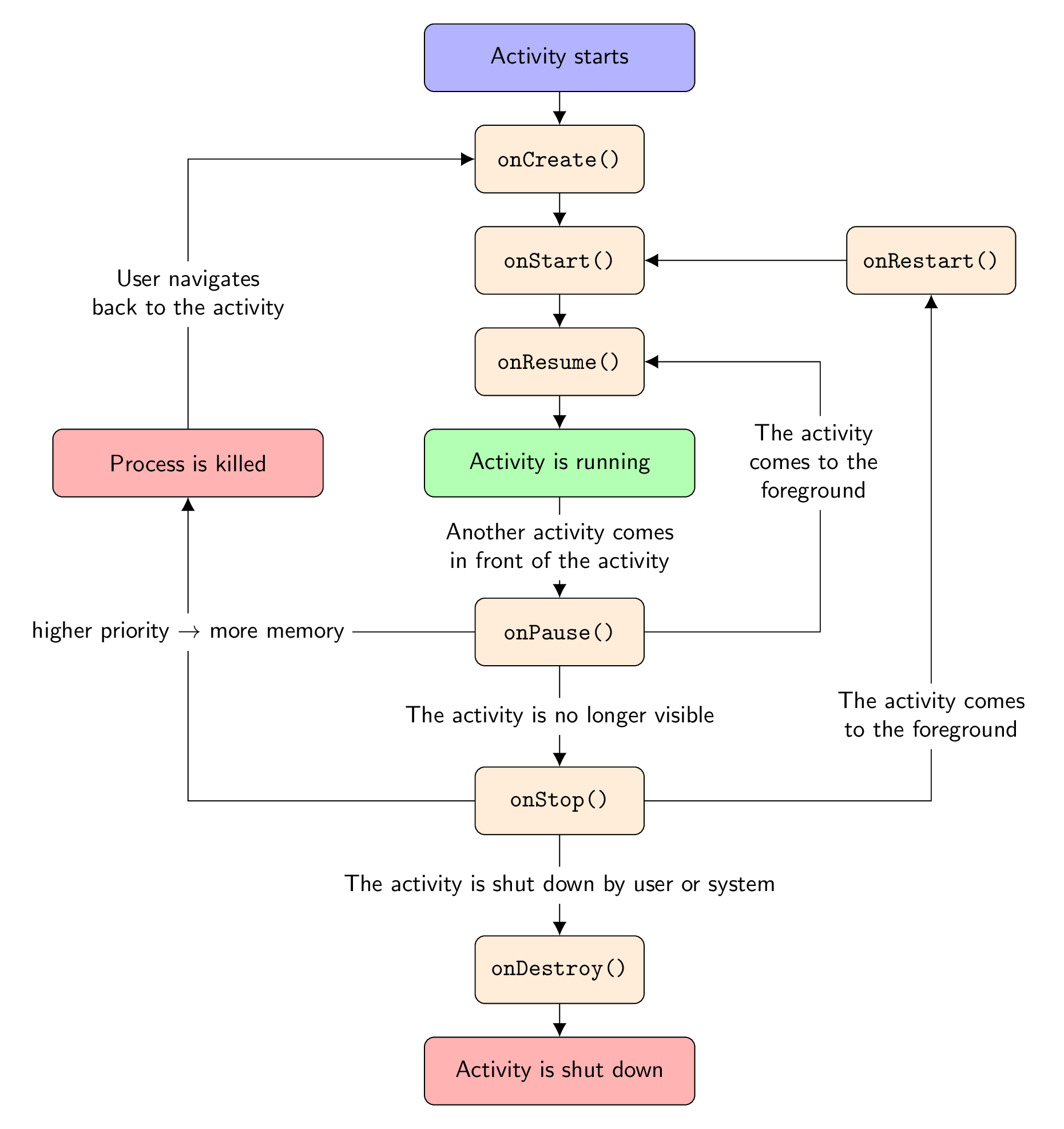Description
The code is a LaTeX document that generates a diagram of the Android activity life cycle using the TikZ package. The diagram consists of rectangular nodes with rounded corners, each with a different color to represent a different stage of the activity's life cycle. The arrows between the nodes indicate the transitions between the different stages. The code includes specifications for the style of the nodes and the arrows, as well as the distance between nodes and the alignment of the text inside the nodes. Each node is labeled with a function that is called during the activity's life cycle. Additionally, the code includes text annotations for some of the arrows to provide additional context for the transitions.
Keywords
tikz, nodes, arrows, activity, life cycle, LaTeX
Source Code

% Diagram of Android activity life cycle
% Author: Pavel Seda
\documentclass[border=10pt]{standalone}
\usepackage{tikz}
\usetikzlibrary{arrows.meta}
\tikzset{%
>={Latex[width=2mm,length=2mm]},
% Specifications for style of nodes:
base/.style = {rectangle, rounded corners, draw=black,
minimum width=4cm, minimum height=1cm,
text centered, font=\sffamily},
activityStarts/.style = {base, fill=blue!30},
startstop/.style = {base, fill=red!30},
activityRuns/.style = {base, fill=green!30},
process/.style = {base, minimum width=2.5cm, fill=orange!15,
font=\ttfamily},
}
\begin{document}
% Drawing part, node distance is 1.5 cm and every node
% is prefilled with white background
\begin{tikzpicture}[node distance=1.5cm,
every node/.style={fill=white, font=\sffamily}, align=center]
% Specification of nodes (position, etc.)
\node (start) [activityStarts] {Activity starts};
\node (onCreateBlock) [process, below of=start] {onCreate()};
\node (onStartBlock) [process, below of=onCreateBlock] {onStart()};
\node (onResumeBlock) [process, below of=onStartBlock] {onResume()};
\node (activityRuns) [activityRuns, below of=onResumeBlock]
{Activity is running};
\node (onPauseBlock) [process, below of=activityRuns, yshift=-1cm]
{onPause()};
\node (onStopBlock) [process, below of=onPauseBlock, yshift=-1cm]
{onStop()};
\node (onDestroyBlock) [process, below of=onStopBlock, yshift=-1cm]
{onDestroy()};
\node (onRestartBlock) [process, right of=onStartBlock, xshift=4cm]
{onRestart()};
\node (ActivityEnds) [startstop, left of=activityRuns, xshift=-4cm]
{Process is killed};
\node (ActivityDestroyed) [startstop, below of=onDestroyBlock]
{Activity is shut down};
% Specification of lines between nodes specified above
% with aditional nodes for description
\draw[->] (start) -- (onCreateBlock);
\draw[->] (onCreateBlock) -- (onStartBlock);
\draw[->] (onStartBlock) -- (onResumeBlock);
\draw[->] (onResumeBlock) -- (activityRuns);
\draw[->] (activityRuns) -- node[text width=4cm]
{Another activity comes in
front of the activity} (onPauseBlock);
\draw[->] (onPauseBlock) -- node {The activity is no longer visible}
(onStopBlock);
\draw[->] (onStopBlock) -- node {The activity is shut down by
user or system} (onDestroyBlock);
\draw[->] (onRestartBlock) -- (onStartBlock);
\draw[->] (onStopBlock) -| node[yshift=1.25cm, text width=3cm]
{The activity comes to the foreground}
(onRestartBlock);
\draw[->] (onDestroyBlock) -- (ActivityDestroyed);
\draw[->] (onPauseBlock) -| node(priorityXMemory)
{higher priority $\rightarrow$ more memory}
(ActivityEnds);
\draw (onStopBlock) -| (priorityXMemory);
\draw[->] (ActivityEnds) |- node [yshift=-2cm, text width=3.1cm]
{User navigates back to the activity}
(onCreateBlock);
\draw[->] (onPauseBlock.east) -- ++(2.6,0) -- ++(0,2) -- ++(0,2) --
node[xshift=1.2cm,yshift=-1.5cm, text width=2.5cm]
{The activity comes to the foreground}(onResumeBlock.east);
\end{tikzpicture}
\end{document}